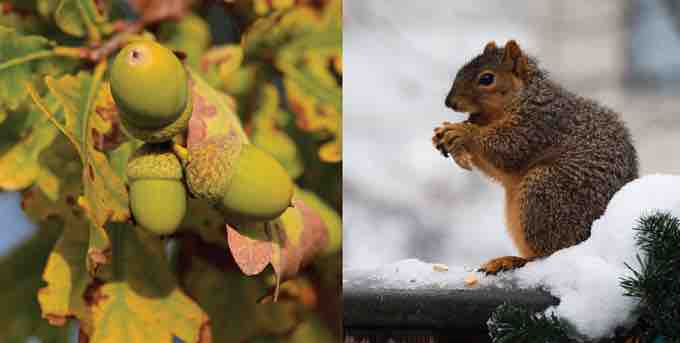Metabolism of Carbohydrates
Carbohydrates are one of the major forms of energy for animals and plants. Plants build carbohydrates using light energy from the sun (during the process of photosynthesis), while animals eat plants or other animals to obtain carbohydrates. Plants store carbohydrates in long polysaccharides chains called starch, while animals store carbohydrates as the molecule glycogen. These large polysaccharides contain many chemical bonds and therefore store a lot of chemical energy. When these molecules are broken down during metabolism, the energy in the chemical bonds is released and can be harnessed for cellular processes.

All living things use carbohydrates as a form of energy.
Plants, like this oak tree and acorn, use energy from sunlight to make sugar and other organic molecules. Both plants and animals (like this squirrel) use cellular respiration to derive energy from the organic molecules originally produced by plants
Energy Production from Carbohydrates (Cellular Respiration)
The metabolism of any monosaccharide (simple sugar) can produce energy for the cell to use. Excess carbohydrates are stored as starch in plants and as glycogen in animals, ready for metabolism if the energy demands of the organism suddenly increase. When those energy demands increase, carbohydrates are broken down into constituent monosaccharides, which are then distributed to all the living cells of an organism. Glucose (C6H12O6) is a common example of the monosaccharides used for energy production.
Inside the cell, each sugar molecule is broken down through a complex series of chemical reactions. As chemical energy is released from the bonds in the monosaccharide, it is harnessed to synthesize high-energy adenosine triphosphate (ATP) molecules. ATP is the primary energy currency of all cells. Just as the dollar is used as currency to buy goods, cells use molecules of ATP to perform immediate work and power chemical reactions.
The breakdown of glucose during metabolism is call cellular respiration can be described by the equation:
Producing Carbohydrates (Photosynthesis)
Plants and some other types of organisms produce carbohydrates through the process called photosynthesis. During photosynthesis, plants convert light energy into chemical energy by building carbon dioxide gas molecules (CO2) into sugar molecules like glucose. Because this process involves building bonds to synthesize a large molecule, it requires an input of energy (light) to proceed. The synthesis of glucose by photosynthesis is described by this equation (notice that it is the reverse of the previous equation):
As part of plants' chemical processes, glucose molecules can be combined with and converted into other types of sugars. In plants, glucose is stored in the form of starch, which can be broken down back into glucose via cellular respiration in order to supply ATP.